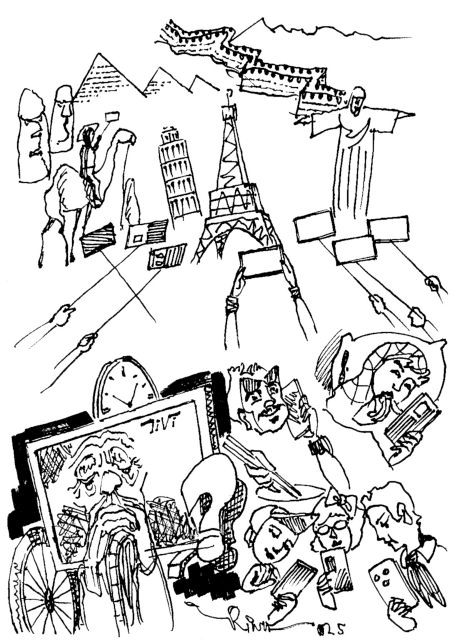 Talk Around Town
Talk Around Town

What do you usually do after posting a photo online? I constantly refresh the post to count the number of “likes” I receive.
 |
By An Phương
HCM CITY – What do you usually do after posting a photo online? I constantly refresh the post to count the number of “likes” I receive.
Most of my friends, who are between 18 and 29 years old, enjoy being “liked” on the social media, especially on Instagram.
“I find it encouraging when people like my #OOTD (Outfit of the Day) photo on Instagram. They must have cared and liked my outfit enough to give a thumbs up,” Huy Hoàng, 26, said.
“I usually get 125 likes for each photo. Considering that I have 750 followers on Instagram, I think I’m socially accepted,” he added.
Huy Anh, Hoàng’s younger brother, told me that as long as one-tenth of the total number of followers and friends like a post, our account will be considered impressive.
“I have a total of 3,782 followers and each of my #OOTD photos is liked 700 times. Honestly, people’s support via the like button makes me feel loved and stressed at the same time as I need to regularly update my wardrobe and stay active online,” Huy Anh said.
I totally feel for Huy Anh.
Since I appreciate people’s support and enjoy the feeling of being “liked”, I’ve often caught myself struggling to gather outfits, pose for a photo and write a meaningful caption, each time a bit differently, to grab and maintain people’s attention.
I feel good when my photos reach the number of likes that I want. And I become more ambitious as the number of my friends and followers grows.
“Day by day, the level of stress seems to grow now that everyone’s #OOTD game is strong,” Huy Anh said.
Since its launch in 2009, the like button, in my opinion, has become the low-hanging digital fruit for human connection across all social networks.
In fact, with the significant amount of interaction you may get, including likes, followers, and comments, you can become an influencer who lives off online content.
“Influencer marketing started booming in Việt Nam last year,” Huy Hoàng said.
Recently, I saw an article in Time magazine which said the photo of an ordinary egg on a white background was the most-liked post on Instagram. The picture has been liked 52 million times since January 4, dethroning Kylie Jenner’s birth announcement photo in February 2018 which had about 18 million likes.
This record got me questioning the true meaning of the like button, now that an insentient object (of course, I’m not counting what’s inside the egg) can attract such global attention.
“I find it both funny and ironic at the same time. Funny how many people are joining in to create a world record, and ironic how much effort I’ve been wasting to come up with quality posts that don’t even gain a fraction of the ‘thumbs up’ for the egg photo,” Huy Anh said.
I agreed with Huy Anh, and though I should never rely on the number of likes to count people’s support, I am often lost in the addictive feedback loop where a constant dispensing of positive affirmation decays into self-doubt when the number of likes for each photo stops increasing.
Another friend of mine, Thanh Thanh, 29, shared an interesting opinion. “Since social media users are limited to how they can conveniently express their voice online except for typing a comment, the like button becomes an ‘easy way out’.”
Huy Hoàng agreed, adding that the photo of an egg may serve a collective purpose, in which the like button is just a way to achieve the desired target.
Thanh Thanh and Huy Hoàng’s insights sort of enlightened Huy Anh and me.
“I won’t say that I’m superficial for depending on the like button to get a sense of social acceptance and fulfillment. Instead, I just really enjoy creating unique content, and hard work should pay off right?” Huy Anh joked.
“That being said, I admit that I have let the number of likes determine my happiness or at least how I feel, as I have often caught myself refreshing a post multiple times. And, I got upset when a photo didn’t receive the number of likes that I wanted,” he said.
This year, Huy Anh and I have decided to change this mindset. We will continue creating content that is meaningful, but we won’t take the like button as seriously as we used to do.
“I promise not to stress myself out because getting likes doesn’t necessarily mean we are genuinely liked by a person, and the like button doesn’t tell us our value,” Huy Anh said.
I believe the experiences of Huy Anh and myself are relevant to most teenagers and young adults.
“If you are a social media-addict like us or would love to become an influencer, check the demographics and the number reached, the impressions, and the comments, besides the likes! Those figures tell a lot more,” Huy Anh said, adding that likes can be bought easily these days.
Thanh Thanh added that there are many scenarios when it comes to making a “like” decision.
“Sometimes I like a post in order to be liked back, and other times I like a post to give a ‘like’ an impression that I’m friendly,” Thanh Thanh said. “Friendliness brings positivity and it may eventually benefit my real-life social interaction.”
Thanh Thanh has a point. We should focus on what matters in real life using social media in general and the like button in particular as an extra tool to make our offline interactions easier.
I am now 26 years old, and I have finally understood the real power of the like button. Of course, everyone has a different take, so what’s your opinion? –VNS




